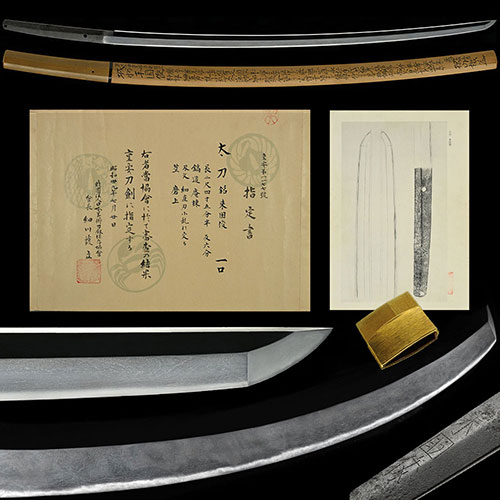
来国俊 脇差 Raikunitoshi Wakizashi
No.633799脇差 来国俊 重要候補 沸匂深く乱れ映り立ち華やかに丁子乱れる最高傑作 時代黒蝋色塗拵付 一尺五寸四分Wakizashi Raikunitoshi Juyo Candedate NieNioi deeply Midare-Utsuritachi Gorgeous CHoujimidare A masterpiece with Jidai-Kuro-RouironuriKoshirae 46.6cm
ご成約Sold
関連商品
- 極めKiwame
- 来国俊Raikunitoshi
- 登録証Registration
- 岐阜県 Gifu 昭和58年10月21日 10/21/58(Showa)
- 時代Period
- 鎌倉時代Kamakura Era
- 法量Size
-
刃長 46.6cm (一尺五寸四分) 反り 1.6cm
元幅 2.7cm 先幅 2.0cm 元重 0.58cm 鎬厚 0.60cm 先重 0.42cm 鋒長 3.2cm 茎長 13.8cm 重量 366gHachou 46.6cm (一尺五寸四分) Sori 1.6cm
Moto-Haba 2.7cm Saki-Haba 2.0cm Moto-Kasane 0.58cm Shinogi-Thikess 0.60cm Saki-Kasane 0.42cm Kissaki-Chou 3.2cm Nakago-Chou 13.8cm Weight 366g - 国Country
- 山城Yamashiro
- 姿Shape
- 鎬造、庵棟、身幅尋常、反り深く、中鋒。Shinogidukuri, Iorimune, Standard Mihaba, Deep Sori, Chu-Kissaki
- 鍛Kitae
- 板目肌に、杢目交じり、地沸微塵に厚くつき、地景よく入り、乱れ映り立つ。Itamehada, Mixed Mokume, Jinie entered fine and thickly, Chikei entered well, Midare-Utsuritatsu
- 刃文Hamon
- のたれて、互の目に丁子刃交じり、湯走り・飛び焼き頻りに掛り、足・葉頻りに入り、小沸深くよくつき、金筋頻りに掛り、匂深く、匂口明るく冴える。Notare, Gnome and Mixed Choujiba, Yubashiri, Tobiyaki-shikirinikakari, There are many Ashi and You, Small-Nie entered deeply, Kinsuji-shikirinikakari, Deep Nioi, Nioikuchi is bright and clear.
- 茎Nakago
- 大磨上、先切、鑢目切、目釘孔二内一埋Oh-suriage, Sakikiri, Yasurimegiri, Mekugiana are two in one filling
- ハバキHabaki
- 金着二重Double gold
- 拵Sword mounitings
- 黒蝋色塗鞘拵[江戸時代]
法量
長さ66.0cm 反り2.6cm<
説明
鐔 鉄地金象嵌。 縁頭 赤銅魚子地家紋散金色絵。 目貫 美濃 金無垢秋草図。 小柄 赤銅魚子地獅子図金据紋。Kuro Rouiro Nurizaya-Koshirae(Edo era)
Length :66.0cm
Sori :2.6cm
Tsuba: Tetsuji-Kinzougan
Fuchigashira: Syakudounanakoji Kamon Chirashi Kiniroe
Menuki: Mino Kinmuku Akikusa-zu
Koduka: Syakudounanakoji Shishizu Kinsuemon - 説明Drscription
- 来派は、国行を始祖とする一派で、鎌倉後期頃には粟田口派に交代するように、山城を代表する刀工群となった。来国俊は、来国行の子と伝え、所謂二字国俊と来国俊三字銘のものがあるが、両者の制作年代を合わせると弘安元年から元亨元年まで四十年間、また古剣書には九十余歳まで生きたとの記載があり、同一人物であったと思われる。しかし両者の作風にはかなりの相違があり、豪壮な体配に華麗な丁子乱れを得意とする二字国俊に対し、来国俊は、上品な直刃調の刃文のものが多く、作風的な面での区分はある程度可能である。また二字国俊には短刀が僅かに一口しか存在しないが、来国俊には数多くの短刀の遺例が見られる。来一門は、国行を始めとして、来国俊、来国光、来国次と一門の直系がいずれも最上作となっている。この刀は、反り深く、先幅広く、猪首風となる小太刀で、板目肌に、杢目交じり、地沸つき地景入り、乱れ映りが立つ美しい地鉄に、互の目に、丁子刃・湯走り・飛び焼きなど交じる華やかな刃を焼き、足・葉よく入り、小沸深くよくつき、金筋・砂流し掛り、匂深く、匂口明るく冴える最高傑作である。The Rai school was a school founded by Kuniyuki, and in the late Kamakura period, it became a group of swordsmiths representing Yamashiro, replacing the Awataguchi school. Rai Kunitoshi is said to be the son of Rai Kuniyuki, and there is still no definite conclusion as to whether the so-called two-character Kunitoshi and Rai Kunitoshi three-character inscriptions are doujins. Combining the years of production of both swords extends from the 1st year of Koan to the 1st year of Genkyo, and it is not unreasonable to think that the span of 40 years is the period of one swordsmith's work. However, there is a considerable difference between the styles of the two.In contrast to Kunitoshi Niji, who specializes in splendid clove disorder with a magnificent appearance, Kunitoshi Rai has many elegant straight blade patterns. It is possible to some extent to classify them in terms of style. In addition, Kunitoshi Niji has only one short sword, but Kunitoshi Rai has many examples of short swords. The Rai family, including Kuniyuki, Rai Kunitoshi, Rai Kunimitsu, Rai Kunitsugu, and the direct lineage of the Rai family are all the best works.
This sword is Deep Sori, Wide Sakihaba, With a Kodachi that looks like Inokubi-style, Itamehada, Mixed Mokume, Jinie-tsuki and Chikei entered Midare-Utsuritachi beautiful Jigane, Gunome, Choujiba, Yubashiri and mixed Tobiyaki with Gorgeous Yaiba-yaki, There are many Ashi and You, Small-Nie entered deeply, Kinsuji and Sunagashikakari, Deep Nioi, Nioikuchi ias bright and clear, A masterpiece.




